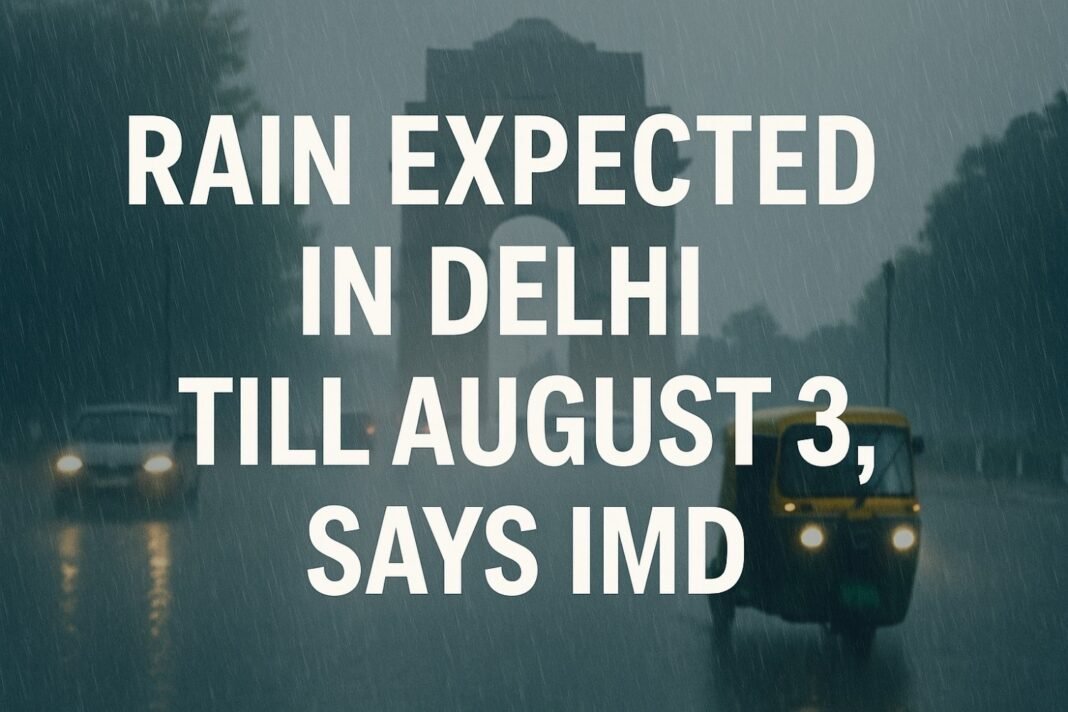Rain Soaks Delhi as IMD Forecasts Wet Spell Till August 3
Delhi woke up to a rainy and cloudy morning on Thursday, as light to moderate rainfall continued across the national capital and its surrounding areas. The India Meteorological Department (IMD) has predicted that this wet weather pattern is likely to persist till August 3, offering much-needed relief from the recent heat while also keeping pollution levels in check.
The ongoing spell of rain began on Wednesday night, with intermittent showers recorded through the early hours of Thursday. The weather department has not issued any weather warning for the city, indicating that while rainfall will continue, it is not expected to reach hazardous levels.
According to IMD data, the minimum temperature in Delhi settled at 24.7 degrees Celsius, which is 1.1 degrees below the seasonal average. The moderate temperature, accompanied by consistent cloud cover, created a cool and pleasant start to the day for residents.
Light to moderate rainfall accompanied with light thunderstorm and lightning is very likely to occur at NCR Bahadurgarh, Manesar) Light rainfall is very likely to occur at entire Delhi, NCR ( Loni Dehat, Hindon AF Station, Ghaziabad, Indirapuram, Chhapraula, Noida, Greater… pic.twitter.com/wFZSJs4cwA
— India Meteorological Department (@Indiametdept) July 31, 2025
Rainfall Measured Across Delhi NCR
In the 24-hour period leading up to 6:30 am on Thursday, several parts of Delhi recorded significant rainfall. Salwan Public School in East Delhi saw the highest rainfall at 42 mm, followed closely by the Pusa area in Central Delhi with 40 mm. The Sports Complex in New Delhi recorded 38 mm, while Safdarjung, a key weather station in Southwest Delhi, measured 34 mm of rainfall.
Other notable figures include Najafgarh with 23.5 mm, Pragati Maidan at 22.1 mm, and KV Narayana at 20.5 mm. Lodhi Road received 18.5 mm, KV Janakpuri 18 mm, and Ayanagar saw a lighter spell with 13 mm of rain.
Morning showers also lashed prominent areas such as Janpath, Lajpat Nagar, and the Minto Bridge, causing waterlogging in a few low-lying areas but not disrupting overall city movement significantly.
Broader NCR Also Likely to See Rainfall
The Indian Meteorological Department has also issued forecasts for neighboring regions of the National Capital Region (NCR). Areas like Bahadurgarh and Manesar are likely to experience light to moderate rainfall, accompanied by occasional thunderstorms and lightning.
In an update shared on X (formerly Twitter), the IMD stated: “Light to moderate rainfall accompanied with light thunderstorm and lightning is very likely to occur at NCR, Bahadurgarh, Manesar. Light rainfall is very likely to occur at the entire Delhi, NCR (Loni Dehat, Hindon AF Station, Ghaziabad, Indirapuram, Chhapraula, Noida, Greater Noida, Gurugram, Faridabad, Ballabhgarh) and very light rainfall/drizzle is very likely to occur over the entire Delhi during the next 2 hours.”
This widespread forecast suggests that the rainfall pattern is not limited to the capital city but is part of a larger weather system impacting northern India.
Air Quality Remains in ‘Satisfactory’ Category
Alongside the rain, another piece of good news for Delhi residents is the air quality. As of 11 am on Thursday, the Central Pollution Control Board (CPCB) recorded the Air Quality Index (AQI) at 56, placing it in the ‘satisfactory’ category.
For reference, the CPCB classifies AQI readings as follows: 0–50 is ‘good’, 51–100 is ‘satisfactory’, 101–200 is ‘moderate’, 201–300 is ‘poor’, 301–400 is ‘very poor’, and 401–500 is categorized as ‘severe’. The rainfall has played a crucial role in settling dust and other air pollutants, contributing to the improved air quality across the capital.
Outlook for the Coming Days
With the IMD predicting continued light to moderate rain over the next few days, Delhi is likely to see consistent cloud cover, cooler-than-usual temperatures, and damp conditions till at least August 3. While the showers are not expected to disrupt daily life in a major way, residents are advised to carry umbrellas, avoid waterlogged routes, and stay updated on local advisories.
As monsoon conditions persist, the rain is providing a much-needed break from the oppressive heat while also helping maintain favorable environmental conditions in one of the world’s most densely populated urban centers.








